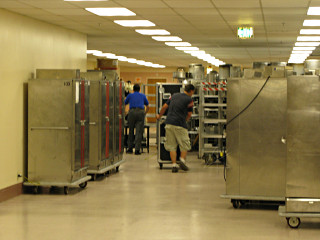
RoadtripPart 6: doing tech at Denvention |
Part 1:
first leg to Hybridfest
Part 2: local Wisconsin tourism and slightly beyond Part 3: South Dakota, Black Hills Part 4: bangin' around the Northwest Part 5: meandering east toward Denver Part 6: doing tech at Denvention (aka Worldcon) Part 7: the journey home |
|
Readers looking for more roadtrip details can optionally skip this section,
as there's almost no travel involved and it delves more into theatre tech
in largish venues and some of the back-end activity that happens around a
science fiction convention. Coming out to help with this was one of the
major factors behind the surrounding trip, however! So now it was time for
me to fulfill the whole reason for aiming toward Denver [however indirectly]
in the first place.
My local host graciously offered to ferry me into town and drop me off at the hotel I'd be staying in, *and* back out later, while I could leave my car parked at his apartment building for free and with very few worries. That relieved me of one major unsolved worry about this trip -- where I was going to park the car for a week and have both it and my wallet intact afterward. The convention took place in the big Denver convention center and a few surrounding hotels, as another in the ongoing series organized by the World Science Fiction Society. The big annual ones happen in the US every two years, with the alternate years held in other countries around the world. It is where the Hugos are awarded, the most prestigious award for works of the genre including full novels, short stories, art, and movies. There are many regional science fiction conventions throughout the year, but all generally smaller than the worldcons. |
|
I hooked up with the other people in the hotel room to drop off my stuff, and
headed for an ongoing meeting and then over to the convention center to find
everyone else. It was nice to see a bunch of familiar faces after all that
strange new scenery, and a bit of a reality hit as it began to sink in that
I'd driven about 6000 miles just to be here!
After a bit of confab and picking up badges, word came in that there was a little present waiting for us in a particular loading dock. |
|
Upon finally popping back out into civilization through one of those "staff
only" doors, I found where the rest of the tech group had gone but still no
meaningful tasks to do. I gave up and went back to the convention center to
see if anything needed doing over there. The advance answer was "unlikely"
since we really didn't have the spaces to work in yet, but just getting my
bearings in that big barn of a place couldn't hurt.
At the far end of the building lay the Wells Fargo theatre space, which this evening had at least one door open into it and appeared to be entirely deserted. Some of us were about to spend quite a lot of time in this room over the next few days, so this presented a fine opportunity for an unrestricted look-see around. I could see worklights on up above, and headed up one of the ladders at the back wall of the stage. |
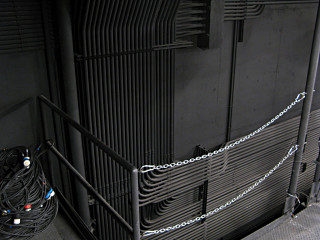
|
An extensive maze of conduit starts on the upstage wall and feeds out to circuits all around the place. The dimmer room is probably close to here, but I never found where it is. |
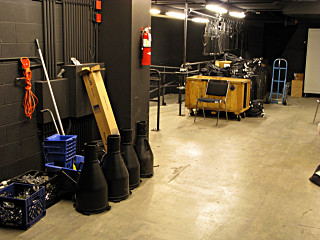
|
There are storage and work areas at either side of the over-stage grid, which seem fairly neatly maintained. The units hanging up are those horrid Source Four zooms that I've never heard anything but complaints about. |
|
Part of the work needed would be a large lighting hang in that very same Wells
Fargo space, except that none of our crew would be physically doing it. David,
the designer, would just be calling the shots from the ground and not even
until everything was hung and working. It's an IATSE union house, and almost
everything from a setup standpoint had to be handled by the in-house personnel
or their immediately-known vendor staff. While this was a little frustrating
on one hand, on the other it would save our own crew a heck of a lot of work.
The bulk of audio and video cable-running would also be out of our hands;
about all we would get to do would be direct and run the shows.
I poked my head briefly into Fargo that morning; they already had a crew of five or six up in the overhead slammin' away to hang David's plot. From the sounds, they were obviously slinging pipes and truss around to create a few new hang points in the process. I ducked quietly out and left them to it. |
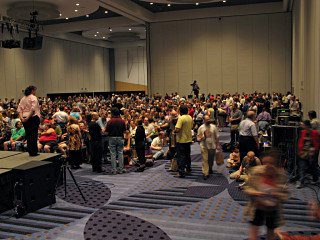
|
We got a fairly good load into the room for the con's Opening Ceremonies that night. |
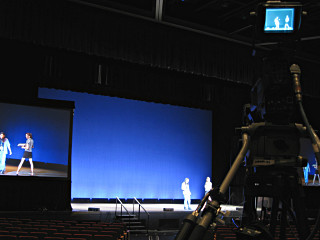
|
Video, meanwhile, was setting up and testing IMAG projectors and a five-camera live shoot for the whole thing. |
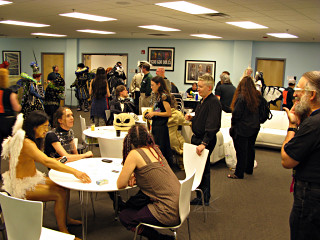
|
Masquerade greenroom off stage right, crowded with contestants as the event opening drew near. |
|
I got no pictures of the masquerade itself, mostly because I was backstage
helping the video director sort out cue-sheets. I'm sure plenty of other
people were out front snappin' away, some results of which may be lurking
in the many sets other people have placed on the web. Here are just a few:
|
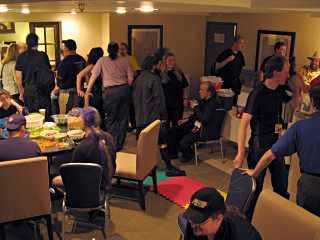
|
The traditional tech party happened after the Masquerade, which usually involves consumption of good single-malt and a whole lot of geeking. |
Scenes from around the con
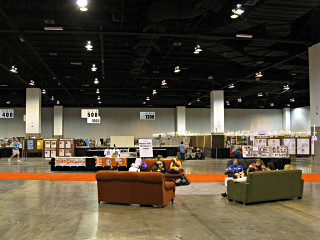
|
Hall D: dealers' room and art show. The art show part toward the right has all the extra light bulbs hung over the panel arrays. |
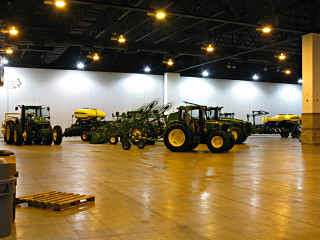
|
In the hall next door, they had just gotten done with a big farm equipment show. This actually looked pretty interesting, except that it was over and they were scrambling to move all this stuff out. |
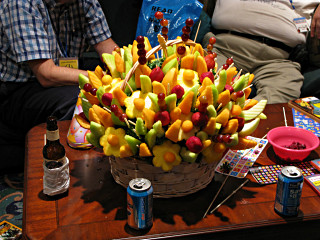
|
Edible Arrangements provided some of the con-suite food. |
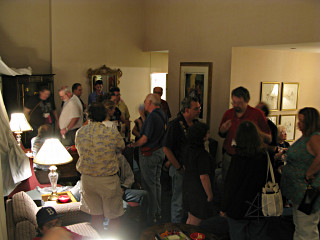
|
But mostly it was wicked crowded and loud in the hallways and party rooms, and I took refuge in the slightly more quiet Arisia party. |
Scenes from around the city
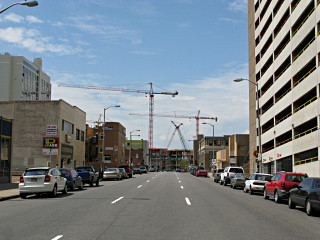
|
A somewhat artsy arrangement of cranes over the several bits of ongoing construction. |
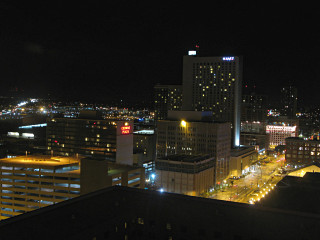
|
Not too bad for a city night shot handheld and just braced against window glass, since I didn't have the tripod with me at the time. |
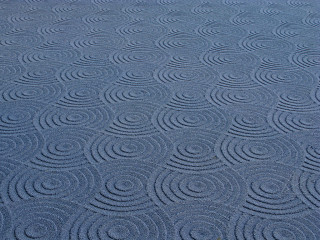
|
Interestingly textured carpet in the convention center. Suitable as a wallpaper, perhaps. |
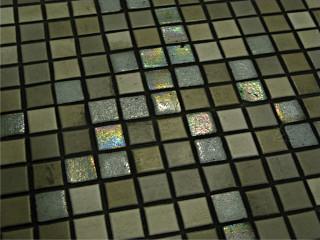
|
Oddly iridescent tiles scattered into the restroom floor. |
|
I suppose my picture-taking does tend toward the relatively nonstandard, such
as intake ducts and lighting galleries and bathroom floors. But really, so
many terabytes' worth of pictures get taken daily of Those Things People Always
Take Pictures Of that there's really no point in doing any more of it. For
example, I flatly refused to take any of the big blue bear artwork outside
the convention center, because simply googling for "blue bear" and "denver"
will return more shots than you'd ever want to see. There were some in the
sets from other people listed above; a couple more relatively coherent
entries are
http://debtorby.typepad.com/connections/2005/10/denvers_big_blu.html http://www.kreysler.com/projects/Blue%20Bear/bluebear.htm the latter of which details some of what went into creating the project. |
Back to work!
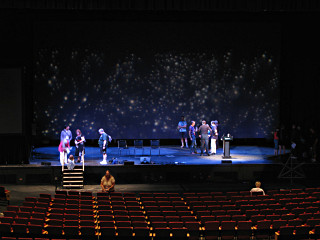
|
Our next major event in the Wells Fargo was the Hugo awards; David more or less turned over the lighting helm to me for this one, and I spent a little while that morning trying to shout over all the other people running around the room to get the union electricians overhead to refocus a few lights for the lectern and stairway. With the star-gobos and some cool night-blue washes, it got to looking sufficiently space-themed for the purpose. |
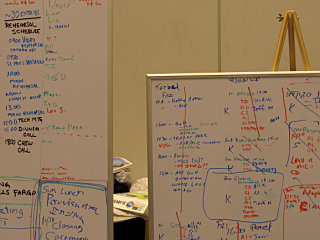
|
By the end of the con, our task and personnel assignment boards had gotten pretty busy. But now, none of it mattered! |
|
Overall the con seemed to go reasonably well. There was almost no load-out
work we needed to do at the Fargo -- other than one or two personal items,
all the gear was rental and would be dealt with by the vendors and in-house
staff. Our technical director declared all the lighting color "expendable"
which would entail refunding what David had spent on it, and we basically
just turned our backs on the place and walked out at the end. Besides,
another big show was due to start loading in very soon after us.
Somewhat ironically, the next gig coming in was Dolly Parton, and I was sure the technical requirements for that would be very different from ours. In fact I was really curious about it, and how they would deal with the venue, and wandered over that way the next morning to see if I could get a glimpse of their load-in. I expected to meet up with all kinds of locked doors and security goons, but as I headed down the "secret stairwell" we had been using all week to get in and out of the space, not only was it open and empty, I could already smell the lingering dope smoke from, uh, roadies taking a break. |
Go to Part 7: the journey home
_H* 081130